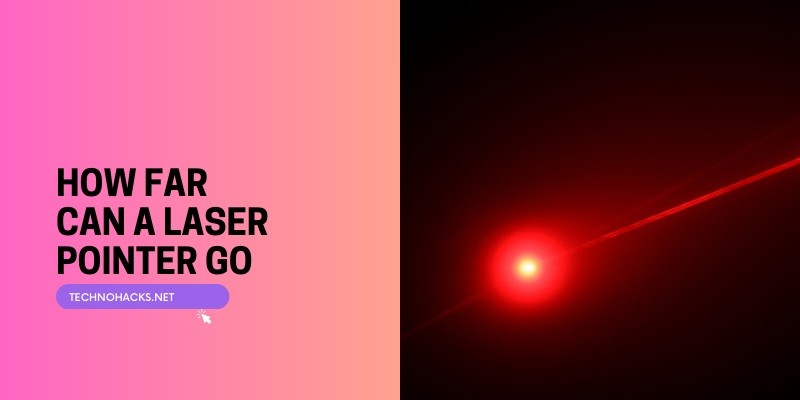How Far Can A Laser Pointer Go?
Laser pointers have become ubiquitous tools for presentations, stargazing, and even as toys. But how far can these handheld devices actually project their beams? The answer depends on several factors, including the laser’s power, wavelength, atmospheric conditions, and what we mean by “go.”
Factors Affecting Laser Pointer Range
The distance a laser pointer’s beam can travel is influenced by several key factors:
- Laser Power: The output power of the laser, measured in milliwatts (mW), is a primary determinant of range. Higher power generally means a longer range.
- Wavelength (Color): Different colors of laser light travel through the atmosphere with varying degrees of scattering and absorption. Green lasers (532 nm) are often perceived as brighter and can appear to travel farther than red lasers (650 nm) of the same power.
- Beam Divergence: This refers to how quickly the laser beam spreads out. Lower divergence means the beam stays more focused over longer distances.
- Atmospheric Conditions: Factors like humidity, dust, and air pollution can scatter and absorb laser light, reducing its effective range.
Theoretical vs. Practical Range
In theory, laser light can travel indefinitely in a vacuum. However, on Earth, atmospheric effects and the curvature of the planet limit the practical range of laser pointers.
For typical consumer laser pointers:
- Low-power red lasers (1-5 mW): Visible spot up to 100-200 meters in ideal conditions.
- Green lasers (5 mW): Visible spots up to 500-1000 meters due to increased eye sensitivity to green light.
- Higher-power lasers (>5 mW): Can be visible for several kilometers, depending on conditions.
It’s important to note that while the beam may travel further, the visible spot on a target becomes increasingly difficult to see at longer ranges due to beam spread and atmospheric effects.
Record-Breaking Distances
While not achievable with handheld laser pointers, some experiments have demonstrated extreme ranges for laser light:
- In 2014, scientists at NASA’s Goddard Space Flight Center in Maryland used a laser to send a high-definition video signal to a detector on the moon, about 384,400 km away.
- Astronomers have used high-powered lasers for adaptive optics, projecting beams up to 90 km into the atmosphere.
These examples use specialized equipment far beyond the capabilities of consumer laser pointers but illustrate the potential distances laser light can travel under ideal conditions.
Safety Considerations and Legal Restrictions
The range of laser pointers is not just a matter of physics but also of safety and legality. Many jurisdictions restrict the sale and use of laser pointers above certain power levels due to potential hazards:
- In the United States, the FDA limits laser pointers sold as demonstration products to Class IIIa (3R), with a maximum power output of 5 mW.
- Higher-powered lasers are classified as Class IIIb or IV and require special precautions and often permits for use.
Safety risks associated with laser pointers include:
- Eye damage: Direct exposure to laser light can cause temporary or permanent vision impairment.
- Distraction hazards: When aimed at vehicles or aircraft, even low-power lasers can cause dangerous distractions.
Legal restrictions often prohibit:
- Aiming lasers at aircraft or vehicles.
- Sale of laser pointers to minors.
- Possession of laser pointers in certain public spaces.
Visible Range by Power and ColorFor green laser pointers (532 nm), which are often perceived as brightest, approximate visible ranges under good conditions are:
- 5 mW: 1-2 miles
- 50-100 mW: 3-5 miles
- 100-200 mW: 5-8 miles
- 200-500 mW: 8-11 miles
- 1000+ mW (1W): 15 miles or more
It’s crucial to note that these ranges are for visibility of the beam itself, not necessarily the spot on a target. The beam becomes visible due to Rayleigh scattering from air molecules and particles, especially in low-light conditions.
Practical Applications and Limitations
While the long-range capabilities of lasers are impressive, practical applications for consumer laser pointers are generally limited to shorter distances:
- Presentations: Typically used within a room, rarely exceeding 50 meters.
- Astronomy: Amateur astronomers use green lasers to point out celestial objects, effective up to several hundred meters.
- Construction alignment: Used for short to medium-range alignment tasks, usually within 100 meters.
For longer-range applications, specialized equipment is required:
- Laser rangefinders: Used in surveying and golf, can measure distances up to several kilometers.
- LiDAR systems: Used in autonomous vehicles and mapping, can detect objects hundreds of meters away.
Atmospheric Effects on Laser Propagation
As laser light travels through the atmosphere, it encounters various phenomena that affect its propagation:
- Scattering: Particles in the air scatter light, reducing the beam’s intensity. Rayleigh scattering affects shorter wavelengths (blue/green) more than longer wavelengths (red).
- Absorption: Water vapor and other atmospheric gases can absorb certain wavelengths of light.
- Refraction: Temperature gradients in the air can bend the laser beam, affecting its path over long distances.
These effects become more pronounced over longer distances, limiting the practical range of laser pointers.
Conclusion
The range of a laser pointer depends on various factors, with power and wavelength being primary determinants. While consumer laser pointers can be visible for several kilometers under ideal conditions, their effective range for practical applications is much shorter. Safety considerations and legal restrictions also play a crucial role in limiting the use of high-powered lasers.

